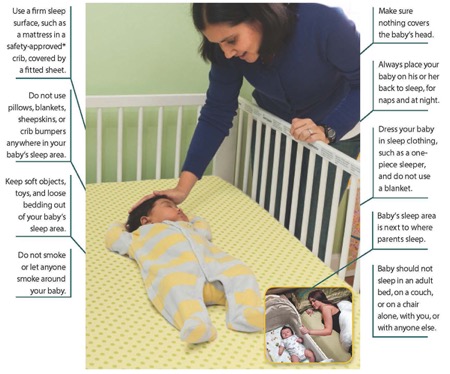Keeping Kids Safe Starts at Home: Safe Sleep Awareness and Laundry Room Safety Tips
Sharing is caring!
Safe Sleep Awareness
Some Quick Definitions1
- Sudden unexpected infant death (SUID): The death of an infant younger than 1 year of age that occurs suddenly and unexpectedly. After a full investigation, these deaths may be diagnosed as suffocation, entrapment, infection, ingestion, metabolic diseases, cardiac arrhythmias, trauma, or SIDS.
- Sudden infant death syndrome (SIDS): The sudden death of an infant younger than 1 year of age that cannot be explained even after a full investigation that includes a complete autopsy, examination of the death scene and review of the clinical history. SIDS is a diagnosis of exclusion and only applies when all other possibilities are eliminated.
SIDS is the number one cause of death among infants aged 1 month to 1 year of age2. In 2015, 3,700 SUID deaths occurred in infants less than one year old in the United States; approximately 1,600 of these deaths were related to SIDS, 1,200 of these deaths were related to unknown causes, and 900 of these deaths were related to accidental suffocation and strangulation in bed3.
There are some easy steps that can be taken to reduce the chance of SIDS and other sleep-related causes of infant death. The Georgia Safe to Sleep campaign recommends following the ABCs of Safe Infant Sleep to keep your baby safe during nighttime sleep and naps1:
- Alone – Babies should sleep alone in their own sleep space, close to but separate from their caregiver. Parents and caregivers are encouraged to share a room with the baby, but avoid sleeping in the same bed with the infant.
- Back – Babies should be placed on their back to sleep. Studies show that placing infants on their back for all sleep times, including naps and at night, reduces the risk of SIDS.
- Crib – Babies should sleep in a crib or bassinet that meets standards set forth by the Consumer Products Safety Commission. The mattress should be firm and covered with a tight-fitting bottom sheet made specifically for the crib. No blankets, quilts, crib bumpers, toys or any objects should be in baby’s sleeping space.
Providing your baby with a safe sleep environment for every sleep is an important way to keep your baby safe and reduce the chance of SIDS or other sleep-related deaths. According to the National Institute for Health, you can provide your baby with a safe sleep environment by2:
- Using a firm surface, such as a mattress in a safety-approved crib, covered by a fitted sheet.
- Removing pillows, blankets, sheepskins, or crib bumpers from your baby’s sleep area.
- Removing soft objects, toys, and loose bedding from your baby’s sleep area.
- Not smoking or letting anyone smoke around your baby.
- Keeping your baby’s head completely uncovered.
- Always placing your baby on his or her back for sleeping, both at nighttime and for naps.
- Dressing your baby in appropriate sleep clothing, such as a one-piece sleeper.
- Having your baby’s sleeping area next to where you sleep.
- Not letting your baby sleep in an adult bed, couch, or chair alone, with you, or with anyone else.

For a downloadable and printable handout of what a safe sleep environment looks like, please follow this link to the National Institute of Health’s Safe to Sleep campaign:
https://www1.nichd.nih.gov/publications/pubs/Documents/Safe_Sleep_Environment_English.pdf
Laundry Room Safety
Babies and little kids are explorers – they learn about their surroundings by touching, feeling, and putting things in their mouths. This exploration is important for their development, so providing them a safe area to do so is essential.
Since 2012, more than 33,000 calls have been made to poison centers related to liquid laundry packet exposures. If a child comes in contact with laundry packets with wet hands or mouths, the packet will dissolve, potentially causing poison-related injury or death. On average, one child is hospitalized or injured as a result of liquid laundry packets per day, with the greatest impact among 1 to 2 year olds. Furthermore, from 2012-2013, approximately 700 children aged 5 years and under were hospitalized or injured as a result of liquid laundry packets. Here are some tips to keep your baby or child safe4:
- Keep liquid laundry packets out of children’s reach and sight.
- Keep packets in their original container and keep the container closed.
- If a child gets into the packets, call the Poison Help number immediately: 1-800-222-1222
For a downloadable and printable list of everything you need to know to keep your children safe around liquid laundry packets, follow this link to Safe Kids Worldwide:
https://www.safekids.org/tip/liquid-laundry-packet-safety-tips-pdf
**Resources:
Join us on Facebook


